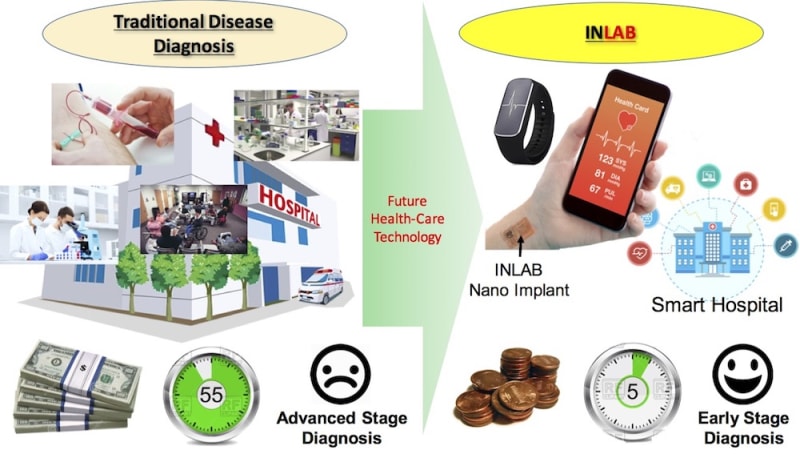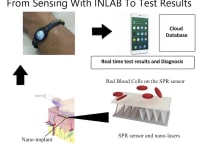Major advancements in the fields of electronics, photonics and wireless communication have enabled the development of compact wearable devices, with applications in diverse domains such as fitness, wellness and medicine. A report published by the International Data Corporation shows a 163.6% increase in wearable device shipments from 28.9 million units in 2014 to 76.1 million units in 2015 and forecasts 173.4 million units by 2019. The most popular wearable devices were medical devices that collect health-related data. Nevertheless, despite their potential, existing wearable devices are only able to measure a few parameters (e.g., heart rate, temperature or blood pressure).
In parallel to these efforts, nanotechnology is enabling the development of miniature sensors that can detect events at the nanoscale with unprecedented accuracy. In-vivo nanosensing systems, which operate inside the human body in real time, have been proposed as a way to provide faster and more accurate disease diagnosis over traditional technologies. For the time being, researchers have successfully employed Surface Plasmon Resonance (SPR) sensors to analyze circulating biomarkers in body fluids for the diagnosis of deadly diseases, ranging from cardiovascular diseases to different types of cancer. Cancer has a huge impact in our society and economy: in 2015, 589,430 US residents died of cancer –that is more than 1,600 people a day– and cancer currently accounts for nearly 1 out of every 4 deaths in the US. Despite the potential of this technology, there are several limitations in the current systems, such as cost and bulkiness of existing portable systems, which limit its real-world impact.
The Implantable Nanoscale LABoratory (INLAB) is the first smart service system for advanced non-invasive health monitoring and diagnosis based on wearable nano-biosensing networks. INLAB bridges the gap between nano-biosensing technologies and commercial wearable devices by synergistically leveraging the state of the art in nanophotonics and wireless communication. INLAB has three components:
• Nanoplasmonic Biochip: Built on a flexible substrate and implanted subcutaneously in the wrist, the biochip (<10 microns) consists of bio-functionalized nano-patterns for grating-coupled SPR-based detection of target biomarkers.
• Nanophotonic Smart Band: Integrated by an array of nano-lasers and photo-detectors, the wearable device is used for distributed excitation and measurement of the nanoplasmonic biochip.
• Diagnosing Software: Advanced signal processing algorithms are utilized to post-equalize the measured signals by taking into account the intra-body channel, filter noise and interference, maximally combine the measured signals and, ultimately, provide reliable data to the healthcare provider.
INLAB utilizes new nano-biosensing strategies able to identify diseases at very early stages. Compared to ex-vivo measurements of blood/tissue samples, which are conducted on samples invasively extracted from the human body, INLAB can track biological processes when and where they occur without any invasive operation. In addition, it saves the time and money that both patients and laboratory staff spend to perform the needed measurements and processing the results. Moreover, early diagnosis of severe diseases such as cancer can drastically increase patients’ survival rate and can save tens of millions of dollars a year through reduced chemotherapy, radiotherapy and surgery.
Video
Like this entry?
-
About the Entrant
- Name:Pedram Johari
- Type of entry:teamTeam members:Pedram Johari
Amit
Josep M. Jornet - Software used for this entry:COMSOL Multiphysics
- Patent status:none





